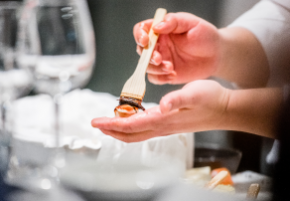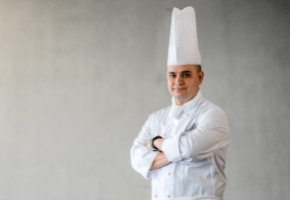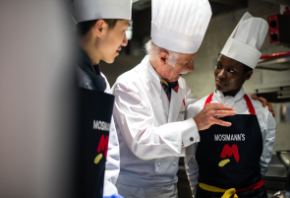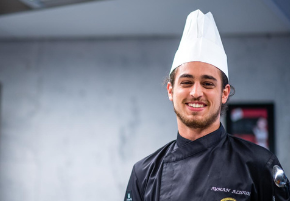- About
- Programs
- Campus Life
- Career Services
- Admissions
- News & Events
- Alumni
Halloween Recipes and Traditions From Around the World
Dive into Halloween recipes from across the globe, exploring symbolic dishes, playful treats, and seasonal foods that celebrate culture and tradition.
Key Takeaways
- Halloween food traditions reflect humanity's shared desire to celebrate change, community, and creativity through what we cook and share.
- Classic Halloween recipes like pumpkin pie, caramel apples, soul cakes, mooncakes, and butter tarts combine seasonal ingredients with playful presentation, turning simple foods into festive symbols.
- Exploring how different cultures mark celebrations through food helps aspiring chefs understand global flavor traditions and develop a deeper appreciation for culinary diversity.
Halloween turns fear into celebration. Every year, neighborhoods fill with flickering lights, people in costume, eerie displays, and haunted houses designed to entertain. The holiday traces back to the ancient Celtic festival of Samhain, when the boundary between the living and the dead was believed to be thin. Over centuries, it shifted from ritual to revelry and turned into a night for imagination, disguise, and shared excitement.
As is the case with so many holidays, food remains one of its strongest traditions. The best Halloween recipes bring the season's spirit to life through creative flavors, autumn ingredients, and just enough eeriness to match the mood of the night.
Halloween Recipes and Traditions Around the World
Halloween today looks very different from its ancient beginnings. It has transformed into a modern, playful celebration, and as the holiday spread and evolved, so did its traditions. Some of the most popular traditions include the following.
United States – Classic trick-or-treat fun
In the U.S., Halloween is less about ancient rituals and more about community and fun. Streets fill with children trick-or-treating in costume, while families host pumpkin-carving contests, costume parties, and decorate their homes with elaborate haunted house displays. The food reflects the season's harvest, with pumpkins, apples, and corn.
Some of the most popular Halloween recipes in the U.S. include:
Pumpkin pie
From Halloween to Thanksgiving, no festive fall dinner feels complete without pumpkin pie.
To prepare, follow these steps:
- Roast and puree fresh pumpkin or use canned puree.
- Whisk with eggs, cream, sugar, and spices (cinnamon, nutmeg, ginger, cloves).
- Pour into a blind-baked pie shell.
- Bake at 175°C (350°F) for 45–50 minutes until set.
- Cool completely before serving.
Caramel apples
A classic treat of harvest fairs and Halloween parties, caramel apples combine crisp fruit with silky sweetness. They are simple yet quite irresistible.
To prepare, follow these steps:
- Insert wooden sticks into clean, dry apples.
- Melt caramel candies with cream over low heat.
- Dip apples and rotate to coat evenly.
- Add toppings like nuts or a chocolate drizzle before setting on parchment.
Popcorn balls
Popular from the 1950s through the 1980s, popcorn balls' nostalgic charm and satisfying crunch still make them a hit at fall gatherings.
To prepare, follow these steps:
- Pop about 10 cups of plain popcorn and remove any unpopped kernels.
- In a saucepan, melt butter with corn syrup, sugar, and a pinch of salt.
- Boil for 2–3 minutes, then remove from heat and stir in vanilla (and food coloring if desired).
- Pour over the popcorn and mix with a wooden spoon until evenly coated.
- Once cool enough to handle, grease your hands and shape into balls.
- Let them set on wax or parchment paper before serving or wrapping.
United Kingdom and Ireland – Samhain roots
In Ireland and parts of the UK, for Halloween, people once lit bonfires, practiced divination, and baked soul cakes. But, over time, these older customs blended with modern pumpkin carving, costume parties, and trick-or-treating.
Some Halloween recipes from this region include:
Soul cakes
Spiced with nutmeg and cinnamon, soul cakes were once left out for wandering spirits or given to the poor in exchange for prayers.
To prepare, follow these steps:
- Cream butter, sugar, and spices such as cinnamon, nutmeg, and allspice.
- Mix in flour, egg yolks, and a little milk until a soft dough forms.
- Roll and cut into circles, then score a cross on each.
- Bake at 175°C (350°F) for 15–20 minutes until lightly golden.
Barmbrack
A fruit-studded tea loaf baked with hidden charms, like a ring for marriage or a thimble for single life. The bread combines sweetness with superstition.
To prepare, follow these steps:
- Soak raisins and currants overnight in strong tea.
- Stir in flour, sugar, egg, and mixed spice.
- Pour into a loaf tin and bake at 175°C (350°F) for about 60 minutes.
- Slice and serve with butter while warm.
Canada – Community and harvest themes
Start Your Culinary Journey
Learn the art of cooking in a world-class environment
In Canada, Halloween carries a strong sense of community. It borrows from American trick-or-treating but also reflects the country's Thanksgiving harvest traditions celebrated earlier in October.
Pumpkins, apples, and maple syrup dominate seasonal dishes, while haunted corn mazes, pumpkin festivals, and neighborhood gatherings bring people together to celebrate autumn. Some classic Canadian Halloween recipes include:
Pumpkin soup
Warm and smooth with gentle spice, pumpkin soup is a favorite during crisp October evenings.
To prepare, follow these steps:
- Roast pumpkin cubes with onions and garlic until soft.
- Blend with vegetable stock until smooth.
- Stir in cream, nutmeg, and black pepper.
- Garnish with toasted pumpkin seeds before serving.
Maple taffy
A simple candy that turns fresh maple syrup into chewy ribbons of sweetness. To prepare, follow these steps:
- Heat pure maple syrup to 113°C (235°F).
- Drizzle over packed snow or crushed ice.
- Roll onto wooden sticks as it cools.
Butter tarts
A hallmark of Canadian baking, these flaky pastries hold a sweet, caramel-like filling of butter, sugar, and eggs. To prepare, follow these steps:
- Line tart tins with pastry dough.
- Whisk melted butter, brown sugar, eggs, and vanilla.
- Pour into the shells and bake at 190°C (375°F) for 15–18 minutes until bubbling.
México – Día de los muertos
In México, Día de los Muertos (Day of the Dead) is one of the most vibrant and meaningful celebrations of the year. Held on November 1 and 2, it honors ancestors and loved ones who have passed, blending pre-Hispanic beliefs with Catholic traditions.
Families build altars (ofrendas) decorated with candles, photographs, paper marigolds (cempasúchil), and favorite foods of the departed. These celebrations extend to cemeteries, where families gather to clean graves, arrange flowers, share tamales, and play music.
Calaveras (skulls) and Catrinas, which are elegant skeleton figures in traditional dress, appear in most of the parades and on altars, symbolizing that death is part of life, not separate from it.
Some traditional recipes from Día de los Muertos include:
Pan de muerto
Soft, fragrant bread flavored with orange and anise, decorated with bone-shaped dough to honor the dead. To prepare, follow these steps:
- Proof yeast with warm milk and sugar.
- Mix in flour, eggs, butter, orange zest, and anise.
- Shape into round loaves and form bone decorations on top.
- Bake at 175°C (350°F) for 30 minutes and brush with butter and sugar.
Sugar skulls
Vivid and colorful, these hand-decorated skulls are made from pressed sugar and used as offerings on altars. To prepare, follow these steps:
- Mix granulated sugar with meringue powder and water.
- Pack tightly into molds and allow to dry overnight.
- Decorate with royal icing and bright designs.
Atole
A warm, thick drink made from masa harina and flavored with cinnamon or chocolate, often served during cemetery vigils. To prepare, follow these steps:
- Dissolve masa harina in water.
- Simmer with milk, sugar, and a cinnamon stick.
- Stir until thickened and serve hot.
Philippines – Undas (All Saints’ and All Souls’ Day)
In the Philippines, Undas is a time for reflection and family gatherings. Families visit cemeteries, clean graves, and share food in honor of their ancestors. The dishes are comforting and portable, often made with rice, coconut, sugar, and other ingredients tied to Filipino hospitality and faith.
Popular Undas recipes include:
Kakanin (Rice cakes)
Sticky and mildly sweet, these rice cakes are often wrapped in banana leaves and shared among relatives.
To prepare, follow these steps:
- Soak glutinous rice and grind it into a paste.
- Mix with coconut milk and sugar.
- Steam in banana leaf-lined molds for 30–40 minutes.
Puto
Soft, fluffy steamed cakes that complement both sweet and savory dishes. To prepare, follow these steps:
- Combine rice flour, sugar, baking powder, and coconut milk.
- Pour into small molds and steam for 15 minutes.
- Top with grated cheese or coconut before serving.
Bibingka
A baked rice cake with a golden crust, traditionally cooked in clay pots lined with banana leaves. To prepare, follow these steps:
- Whisk rice flour, coconut milk, eggs, and sugar.
- Pour into a lined pan and top with salted egg slices.
- Bake at 190°C (375°F) for 25–30 minutes.
- Brush with butter and sprinkle with coconut.
European countries - All Saints’ Day
Across Europe, All Saints' Day on November 1 is a time to honor the dead through prayer and remembrance. The tradition has Christian roots, originating as a feast to celebrate all saints, known and unknown, and later expanding to include departed loved ones. Families visit cemeteries, light candles, and share simple baked goods that carry religious and seasonal meaning.
Unlike the playful costumes and decorations of Halloween, All Saints' Day remains solemn. The foods associated with it include:
Ossa dei Morti (Italy)
Translating to "bones of the dead," these crisp almond cookies are baked in Sicily and other regions of Italy for All Saints' and All Souls' Day. Their shape represents remembrance and the enduring bond between the living and the departed.
To prepare, follow these steps:
- Grind almonds with sugar into a fine mixture.
- Combine with egg whites, lemon zest, and cinnamon.
- Pipe into bone shapes and bake at 160°C (325°F) for about 20 minutes.
Panellets (Spain)
In Catalonia, panellets are shared during La Castanyada, which coincides with All Saints' Day. These small marzipan sweets rolled in pine nuts celebrate the harvest and honor those who have passed.
To prepare, follow these steps:
- Mix almond flour, sugar, and egg yolk to form a dough.
- Shape into small balls and coat with pine nuts.
- Bake at 190°C (375°F) for 12–15 minutes until lightly golden.
Niflettes (France)
In northern France, niflettes are puff pastry tarts filled with almond cream or custard, traditionally offered to comfort mourners. Today they are enjoyed as a seasonal pastry marking remembrance and renewal.
To prepare, follow these steps:
- Roll puff pastry and cut into circles.
- Add a spoonful of almond cream or custard to each.
- Fold, brush with egg wash, and bake at 200°C (400°F) for 20 minutes.
Japan – Kawaii halloween food trends
Halloween in Japan is a spectacle of creativity and color. Adopted in the 1990s, the holiday took on a uniquely Japanese twist through elaborate costumes, themed desserts, and playful presentations.
Instead of fright, the focus is on kawaii (cute) aesthetics, with cafés and bakeries transforming classic sweets into edible art. Seasonal ingredients like pumpkin, sweet potato, and matcha take center stage.
Some of the most popular Japanese Halloween recipes include:
Pumpkin pudding
Smooth and creamy with a gentle sweetness, this custard-style dessert resembles flan and is often molded into pumpkin shapes.
To prepare, follow these steps:
- Blend pumpkin puree with eggs, sugar, and milk until velvety.
- Strain to remove any lumps and pour into caramel-lined molds.
- Steam or bake in a water bath at 160°C (325°F) for about 40 minutes.
- Chill, unmold, and serve with whipped cream or caramel sauce.
Halloween bento boxes
Lunchboxes turned into tiny works of art, with rice ghosts, vegetable pumpkins, and monster-shaped eggs arranged with precision. These bentos are popular among families and at school events.
To prepare, follow these steps:
- Shape warm rice into ghosts using plastic wrap.
- Cut nori into eyes, mouths, and other details.
- Add bright vegetables such as carrots and broccoli for color.
- Arrange proteins and sides neatly in compartments for balance.
Decorated cupcakes
A Western-inspired treat made distinctly Japanese through its attention to detail. Cupcakes are topped with colorful frosting, miniature fondant figures, and chocolate accents.
To prepare, follow these steps:
- Bake vanilla or chocolate cupcakes and let them cool.
- Frost with buttercream tinted orange, purple, or green.
- Decorate with sugar spiders, candy pumpkins, or piped ghosts.
China - Zhongyuan (Hungry ghost festival)
Though it takes place in mid-August on the lunar calendar, China's Zhongyuan Festival, also known as the Hungry Ghost Festival, shares Halloween's focus on remembering the dead and honoring ancestors.
Families prepare offerings of food, burn incense, and perform rituals to comfort wandering spirits. The mood is calm, reflective, and deeply rooted in tradition. Typical festival recipes include:
Steamed buns (Mantou)
Soft, cloud-like buns are offered at family altars as a gesture of respect. Their purity and simplicity reflect humility and devotion.
To prepare, follow these steps:
- Proof yeast with warm water and sugar until frothy.
- Mix with flour and knead until smooth.
- Shape into buns, let rise, and steam for 15 minutes until fluffy.
Rice and fruit platters
These offerings symbolize nourishment and balance. Families prepare bowls of white rice and arrange seasonal fruits like pears, apples, and oranges.
To prepare, follow these steps:
- Cook rice and spoon it into small bowls.
- Slice fruit neatly and place it beside the incense and candles on the altar.
- After rituals, families share the food together as a symbol of unity.
Mooncakes
Dense, decorative pastries filled with lotus seed paste or red bean, often featuring an embossed pattern that represents harmony and completeness.
To prepare, follow these steps:
- Combine flour, golden syrup, and lye water into a soft dough.
- Wrap around your choice of filling and press into traditional molds.
- Bake at 175°C (350°F) for 20 minutes until golden, then cool before serving.
Common Ingredients in Halloween Recipes
Even with all their regional differences, many Halloween and international autumn festival recipes share common ingredients, like pumpkin, apples, rice, sugar, and warming spices like cinnamon, nutmeg, and cloves. These foods link seasonal abundance with comfort and celebration.
The color of the food used is symbolic and adds a layer of meaning to the dish. Orange, the color of pumpkins and autumn leaves, represents harvest and vitality. Black, found in licorice, dark chocolate, and decorations alike, evokes mystery and the unseen. White suggests purity and the presence of spirits, often appearing in sugar icings or ghost-shaped confections. Red, bright in apples, chilies, and festive accents, symbolizes life and protection. These colors create the palette of Halloween, in terms of food and overall aesthetic.
In culinary education, awareness of color and presentation is part of cooking. At Culinary Arts Academy Switzerland, students learn how visual balance, ingredient pairing, and plating techniques enhance both flavor and perception. Through exposure to global cuisines and diverse culinary traditions, they learn to unite taste, texture, and design in ways that reflect both creativity and technical skill.
Learn How to Create Halloween Recipes
Halloween is built on creativity, from the costumes and decorations to the food that fills the table. It's a perfect opportunity to experiment, to be bold with flavors, colors, and ideas. The same imagination that fuels haunted house designs can inspire what happens in the kitchen.
Great Halloween recipes balance originality with skill. Presentation matters just as much as taste, turning familiar ingredients into something playful, eerie, or elegant.
Still, to bring ideas to life, technique and understanding must accompany that creativity. At Culinary Arts Academy, students gain that foundation through hands-on learning in professional kitchens. As Pastry Chef and CAAS alumna Hannah Corado explains, "Being able to study at Culinary Arts Academy in Switzerland is where I learned the most about how a kitchen actually functions." The same precision and care taught in CAAS classrooms can transform your Halloween experiments into refined and flavorful creations.
Our Bachelor of Arts in Culinary Arts program combines advanced cooking techniques with leadership and business training, preparing graduates to manage professional kitchens or launch their own ventures. The Swiss Diploma in Culinary Arts and the Swiss Diploma in Pastry Arts offer focused instruction in classic and contemporary culinary methods, from tempering chocolate to creating balanced flavor compositions.
Many students describe CAAS as a transformative experience. "By fully engaging with the curriculum, I have gained a wealth of insights," says Salman, a CAAS student. "Hospitality and respect, two essential values in my culture, were instilled within me. Additionally, the academy has connected me with a diverse network of individuals from whom I continue to learn and grow."
Global Flavors for Halloween
Halloween recipes reflect humanity's universal instinct to honor seasonal change through food, ritual, and togetherness. Across cultures, these dishes have become part of the visual and emotional language of the season.
For aspiring culinary professionals, these global traditions serve as a masterclass in versatility and technique. They show how the same ingredient can take countless forms: pumpkin becomes soup, pie, or pudding; sugar turns into caramel, toffee, or pressed skulls; rice transforms into cakes, buns, or warming drinks like atole. Learning to see these possibilities is what separates good cooks from great ones.
At Culinary Arts Academy, students explore this same spirit of curiosity and adaptability. Guided by international chef instructors, they learn to combine tradition with innovation, mastering flavor, balance, and presentation across global cuisines. Halloween may come once a year, but the skills it celebrates, like creativity, precision, and cultural awareness, define a lifetime in the kitchen.
Frequently Asked Questions
How can I use leftover Halloween candy in new recipes?
Melt chocolate bars into brownies or ganache; chop candy bars into cookies or ice cream mix-ins; crush hard candies to decorate cupcakes or rim cocktail glasses.
What are fun pumpkin-based treats for a Halloween party?
Try pumpkin-shaped sugar cookies with orange icing, mini pumpkin soup shots served in small cups, pumpkin spice cupcakes, or carved mini pumpkins filled with dip.
Are there healthy alternatives to classic Halloween treats?
Substitute honey or maple syrup for refined sugar in baked goods; make fruit-based "candy" like dried apple chips or frozen banana pops dipped in dark chocolate; use whole-grain flours in cookies and cakes.
What are the best Halloween drinks and party punch ideas?
Serve spiced apple cider (hot or cold), "witch's brew" punch (lime sherbet in ginger ale with dry ice for fog effect), pumpkin spice lattes, or black mocktails made with activated charcoal lemonade.
Interested in studying at CAAS? Download our brochure to learn about our programs!


























